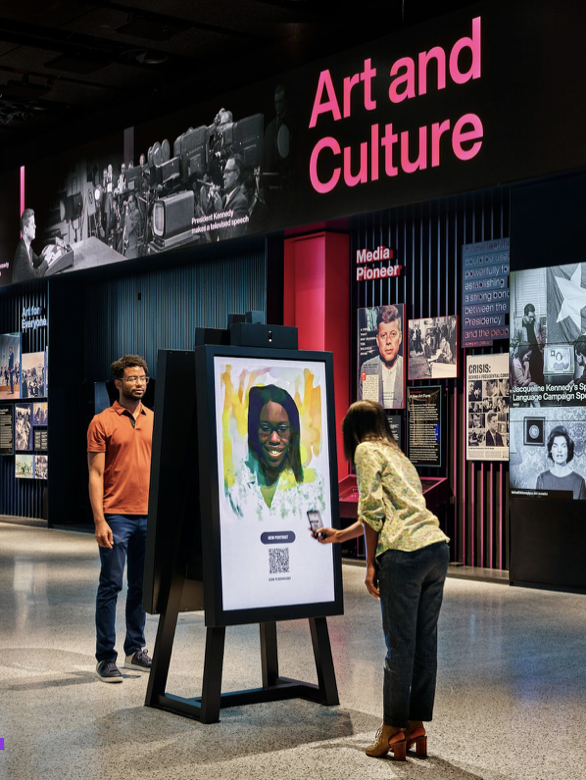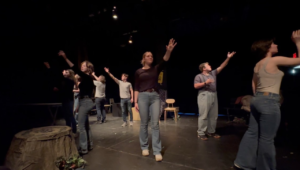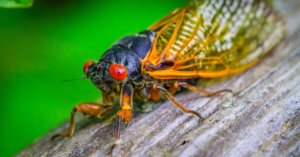Arts and Ideals: The Hot New Exhibition at the Kennedy Center

Courtesy of The Kennedy Center of Performing Arts
By John Maggio
Arts and Ideals: President John F. Kennedy is the newest exhibition at the Kennedy Center for Performing Arts. Opened on the 17th, this new permanent exhibition is centered on the love of the arts that the 35th President and First Lady, Jacqueline Kennedy, shared.
It begins with a short timeline of the former president, telling of the major bullet points of the life of John F. Kennedy, showing guests a vast collection of books that President Kennedy read as a child.
The second oldest of nine children, he was bedridden at a young age due to scarlet fever. His prolonged time bedridden helped him discover his love for literature. He read many classics, from The Jungle Book (1894) and The Arabian Nights (1706) to War & Peace (1869) and Ivanhoe (1819). Having these books and many others that he grew up on display really showed visitors where his love of the arts began. Also on display are the books he wrote himself, the most notable ones being Why England Slept (1940) and Profiles in Courage (1956).
This showcase is more than a timeline of the life of Kennedy, it is a complete audio and visual experience divided into four sections: Art & Democracy, Art & Social Change, Art & Culture, and Art & The White House. Each has different subsections on matters from the media and civil rights art to dance and the great cultural bearers of the time. Each aspect was “thoughtful”, as one guest stated, in what was displayed. She also stated that this exhibition showed who Pres. Kennedy was as a person, not just a politician, and that the “value in [informing] the younger population” is more important than ever in such a “polarizing time”.
One child there said that he “enjoyed” the exhibition and was “taught” much about the life of Pres. Kennedy and his love of the arts. As someone who likes going to the Kennedy Center for musicals, he said that it is “something for younger people”.
When it comes to Kennedy’s love of the arts, this exhibition, and the Kennedy Center as a whole, there is one message at the heart: that art is for the people. That is what the President of the Kennedy Center, Deborah Rutter, had to say. She said that this “living memorial” to JFK is a complete “expression of John and Jackie’s love of arts, culture, and the humanities”. She also says that this is the aim of the Kennedy Center to be as well, to “showcase the diverse arts” of the American people and world.
An intriguing and modern aspect of the exhibition is a new permanent AI feature. Called Dynamic Portraiture by expressionist painter Elaine de Kooning, this screen is where you become the artist of a self-portrait. After choosing a color palette of selected JFK paintings, the guests then paint and sketch with the colors. After some time, AI will capture your photo and then fill in what you painted to make it look like you in the style of your selected JFK image, along with a QR code to download it. Truly something modern to bring in the true experience of the exhibition.
Two guests who are students at American University said that they liked the “appealing design” of the whole exhibition, noting the audio of ‘”Kennedy’s speeches” throughout and lighting. They said that having interactive features to help you be fully immersed in what is being shown is “cool”. This was their first time at the Kennedy Center, seemingly a success in President Rutter’s goal of making the center an “informal” “sandbox” for all types of people and ages.
A worker at the exhibition said that this place is important to bring JFK to “life” to the younger generation, who did not live during the Kennedy administration like herself. For her, she can remember where she was for the major historical events in her life; the same events that younger generations only know through books. This place is able to connect the “legacy” of John and his love of the art to the youth. She also stated that the love of the arts by John and Jacqueline really made the White House the “People’s House” and that John was imaged as the first “People’s President”.






